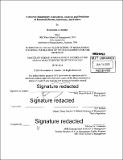| dc.contributor.advisor | S.P. Kothari. | en_US |
| dc.contributor.author | Danilov, Konstantin A | en_US |
| dc.contributor.other | Sloan School of Management. | en_US |
| dc.date.accessioned | 2014-09-19T21:47:50Z | |
| dc.date.available | 2014-09-19T21:47:50Z | |
| dc.date.copyright | 2014 | en_US |
| dc.date.issued | 2014 | en_US |
| dc.identifier.uri | http://hdl.handle.net/1721.1/90237 | |
| dc.description | Thesis: S.M. in Management Studies, Massachusetts Institute of Technology, Sloan School of Management, 2014. | en_US |
| dc.description | Cataloged from PDF version of thesis. | en_US |
| dc.description | Includes bibliographical references (pages 89-90). | en_US |
| dc.description.abstract | This paper is divided into three sections that address the various elements of understanding, predicting and analyzing corporate failure and bankruptcy. Part I covers the definitions of corporate failure, explains the bankruptcy process and then classifies various potential causes of failure into broad categories. The causes are bifurcated into company-specific versus external factors. The company-specific factors include an in depth discussion and analysis of business causes versus financial causes, as well as the interrelation between the two. The most important factors, such as financial and operating leverage, are explored in great detail to gain a better understanding of their implications and impact on corporate failure. Part II covers various approaches for analyzing corporate risk and predicting corporate failure. It first details the credit analysis process from the perspective of lenders and credit agencies as a method for credit evaluation and prediction of default. Then, it provides an in depth explanation of financial ratio analysis as a prediction method and provides an overview of the main statistical prediction models. It concludes with a discussion of the implications of the model findings with respect to the causes detailed in Part I. Lastly, Part III describes the outcome of the study performed to analyze the causes of failure as described in Part I by using a combination of the methods highlighted in Part II. The purpose of the study is to identify the sequence and magnitude of relative ratio deterioration in failed firms in order to establish the relative frequency of the various categories of causes of failure. Various ratios and metrics were used as proxies for relative liquidity complications, profitability issues, business problems, and leverage concerns. The impact of macroeconomic events is also evaluated by isolating the impact of the 2008-2009 recession on the relative ratio measures. | en_US |
| dc.description.statementofresponsibility | by Konstantin A. Danilov. | en_US |
| dc.format.extent | 90 pages | en_US |
| dc.language.iso | eng | en_US |
| dc.publisher | Massachusetts Institute of Technology | en_US |
| dc.rights | M.I.T. theses are protected by copyright. They may be viewed from this source for any purpose, but reproduction or distribution in any format is prohibited without written permission. See provided URL for inquiries about permission. | en_US |
| dc.rights.uri | http://dspace.mit.edu/handle/1721.1/7582 | en_US |
| dc.subject | Sloan School of Management. | en_US |
| dc.title | Corporate bankruptcy : assessment, analysis and prediction of financial distress, insolvency, and failure | en_US |
| dc.type | Thesis | en_US |
| dc.description.degree | S.M. in Management Studies | en_US |
| dc.contributor.department | Sloan School of Management | |
| dc.identifier.oclc | 890377117 | en_US |
